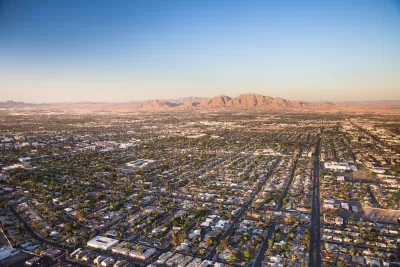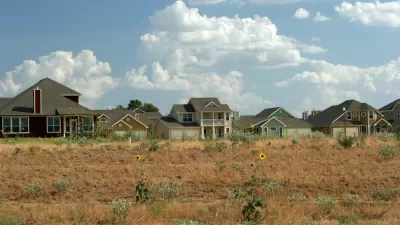Having sprawled for the past few decades, the Las Vegas region is bumping up against undevelopable federal lands. Those limits give it the chance to consider a denser, more urban future.

“At 5,046 residents per square mile, the City of Las Vegas is not exactly Hoboken, but it’s denser than you'd imagine,” writes Josh Stephens in the California Planning & Development Report. “It has plenty of small houses on small lots (making it relatively inexpensive on a per-unit basis), and it has its share of small apartment buildings. Many residents commute to one of the greatest concentrations of employment (especially blue-collar employment) in the country: the Las Vegas Strip. So, there are gravitational forces keeping residents in the city.”
“To its credit, Las Vegas wants to grow. It wants none of the slow-growth paralysis that has hobbled too many parts of California. Unfortunately, Lombardo's plea indicates that he wants Las Vegas to continue to sprawl, presumably by continuing to build inexpensive single-family homes, parking-heavy apartment complexes, and whatever inconsequential commercial developments are needed to keep suburbanites fed, fit, and fueled up.”
“Gov. Lombardo has said that provision of housing 'begins with eliminating governmental barriers to development.' Sure, but it doesn't have to be the federal government that does the eliminating.”
“Back in 1972, architects Robert Venturi, Denise Scott Brown, and Steve Izenour famously celebrated Las Vegas’s design sensibilities. They reveled in the superficiality of signage and simulacra. Now, Las Vegas — not the Strip, but the actual city — faces the opportunity to get real.”
FULL STORY: Las Vegas' Opportunity to Learn from California

Maui's Vacation Rental Debate Turns Ugly
Verbal attacks, misinformation campaigns and fistfights plague a high-stakes debate to convert thousands of vacation rentals into long-term housing.

Planetizen Federal Action Tracker
A weekly monitor of how Trump’s orders and actions are impacting planners and planning in America.

In Urban Planning, AI Prompting Could be the New Design Thinking
Creativity has long been key to great urban design. What if we see AI as our new creative partner?

King County Supportive Housing Program Offers Hope for Unhoused Residents
The county is taking a ‘Housing First’ approach that prioritizes getting people into housing, then offering wraparound supportive services.

Researchers Use AI to Get Clearer Picture of US Housing
Analysts are using artificial intelligence to supercharge their research by allowing them to comb through data faster. Though these AI tools can be error prone, they save time and housing researchers are optimistic about the future.

Making Shared Micromobility More Inclusive
Cities and shared mobility system operators can do more to include people with disabilities in planning and operations, per a new report.
Urban Design for Planners 1: Software Tools
This six-course series explores essential urban design concepts using open source software and equips planners with the tools they need to participate fully in the urban design process.
Planning for Universal Design
Learn the tools for implementing Universal Design in planning regulations.
planning NEXT
Appalachian Highlands Housing Partners
Gallatin County Department of Planning & Community Development
Mpact (founded as Rail~Volution)
City of Camden Redevelopment Agency
City of Astoria
City of Portland
City of Laramie





























